Desa VGMRN, CGMFN, VGMRP, CGMFP User Manual
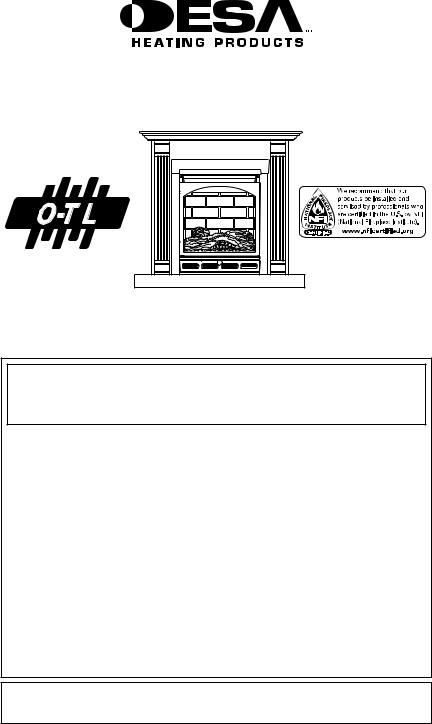
UNVENTED (VENT-FREE) Gas
Mini Compact Fireplace
OWNER’S OPERATION AND INSTALLATION MANUAL
Shown with Optional
Cabinet Mantel/Hearth
Base Accessory
Manual Models CGMFN and CGMFP
Remote-Ready Models VGMRN and VGMRP
WARNING: If the information in this manual is not followed exactly, a fire or explosion may result causing property damage, personal injury or loss of life.
—Do not store or use gasoline or other flammable vapors and liquids in the vicinity of this or any other appliance.
—WHAT TO DO IF YOU SMELL GAS
•Do not try to light any appliance.
•Do not touch any electrical switch; do not use any phone in your building.
•Immediatelycallyourgassupplierfromaneighbor’s phone. Follow the gas supplier’s instructions.
•If you cannot reach your gas supplier, call the fire department.
—Installationandservicemustbeperformedbyaqualified installer, service agency or the gas supplier.
INSTALLER: Leave this manual with the appliance. CONSUMER: Retain this manual for future reference.
For more information, visit www.desatech.com
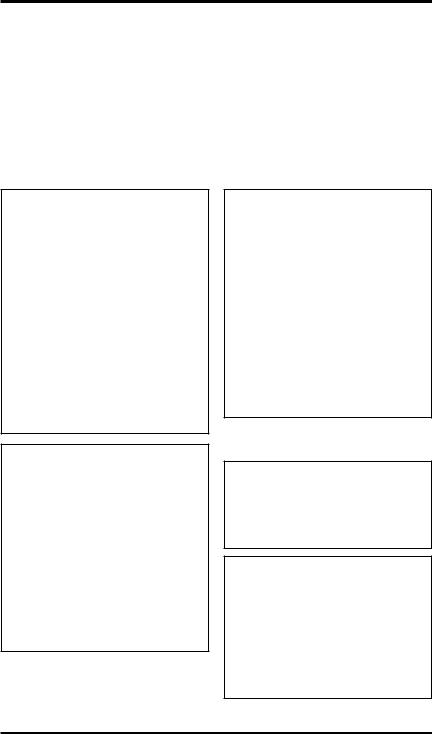
TABLE OF CONTENTS
Safety Information................................................ |
2 |
Local Codes......................................................... |
4 |
Unpacking............................................................ |
4 |
Product Identification............................................ |
5 |
Product Features.................................................. |
5 |
Optional Remote Control Accessories................. |
5 |
Assembly.............................................................. |
5 |
Air for Combustion and Ventilation....................... |
6 |
Installation............................................................ |
9 |
Operating Fireplace............................................ |
18 |
Inspecting Burners............................................. |
23 |
Inspecting Burners............................................. |
24 |
Cleaning and Maintenance................................ |
24 |
Troubleshooting................................................. |
25 |
Specifications..................................................... |
29 |
Wiring Diagram.................................................. |
29 |
Service Hints...................................................... |
29 |
Technical Service............................................... |
29 |
Replacement Parts............................................. |
29 |
Illustrated Parts Breakdown and Parts List........ |
30 |
Accessories........................................................ |
34 |
Safety Information
WARNING: Improper installation, adjustment, alteration, service or maintenance can cause injury or property damage.
Refer to this manual for correct installation and operational procedures.
For assistance or additional information consult a qualified installer, service agency or the gas supplier.
WARNING: This is an unvented gas-fired heater. It uses air (oxygen) from the room in which it is installed. Provisions for adequate combustion and ventilation air must be provided. Refer to Air for Combustion and Ventilation section on page 6 of this manual.
This appliance may be installed in an aftermarket,* permanently located, manufactured (mobile) home, where not prohibited by local codes.
This appliance is only for use with the type of gas indicated on the rating plate. This appliance is not convertible for use with other gases.
* Aftermarket: Completion of sale, not for purpose of resale, from the manufacturer
 WARNING:Thisproductcontainsand/orgenerateschemicals known to the State of California to cause cancer or birth defects or other reproductive harm.
WARNING:Thisproductcontainsand/orgenerateschemicals known to the State of California to cause cancer or birth defects or other reproductive harm.
IMPORTANT: Read this owner’s manualcarefullyandcompletely before trying to assemble, operate or service this fireplace. Improper use of this fireplace can cause serious injury or death from burns, fire, explosion,electricalshockandcarbon monoxide poisoning.
|
www.desatech.com |
119315-01A |
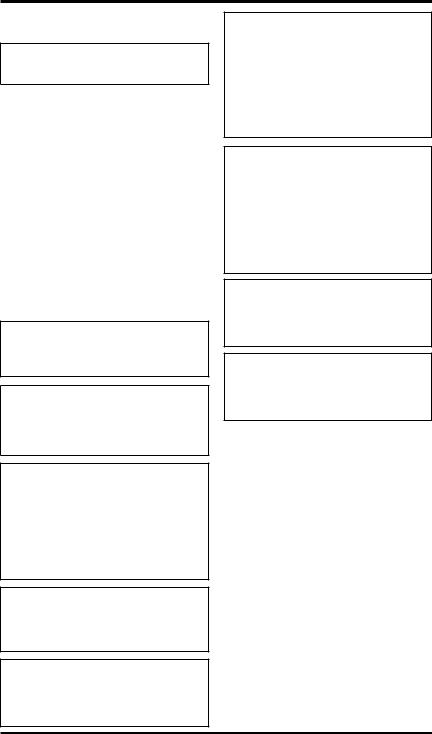
SAFETY INFORMATION
Continued
 DANGER: Carbon monoxide poisoning may lead to death!
DANGER: Carbon monoxide poisoning may lead to death!
CarbonMonoxidePoisoning:Early signs of carbon monoxide poisoning resemble the flu, with head- aches, dizziness or nausea. If you have these signs, the fireplace may not be working properly. Get fresh air at once! Have fireplace serviced. Some people are more affected by carbon monoxide than others.Theseincludepregnantwomen,peoplewith heart or lung disease or anemia, those under the influence of alcohol and those at high altitudes.
Natural and Propane/LP Gas: Natural and pro- pane/LPgasesareodorless.Anodor-makingagent isaddedtothegas.Theodorhelpsyoudetectagas leak. However, the odor added to the gas can fade. Gas may be present even though no odor exists.
Makecertainyoureadandunderstandallwarnings. Keep this manual for reference. It is your guide to safe and proper operation of this fireplace.
 WARNING: Any change to this fireplace or its controls can be dangerous.
WARNING: Any change to this fireplace or its controls can be dangerous.
 WARNING:Donotuseablowerinsert,heatexchangerinsertor otheraccessorynotapprovedfor use with this fireplace.
WARNING:Donotuseablowerinsert,heatexchangerinsertor otheraccessorynotapprovedfor use with this fireplace.
 WARNING: Do not allow fans toblowdirectlyintothefireplace. Avoidanydraftsthatalterburner flame patterns. Ceiling fans can create drafts that alter burner flame patterns. Altered burner patterns can cause sooting.
WARNING: Do not allow fans toblowdirectlyintothefireplace. Avoidanydraftsthatalterburner flame patterns. Ceiling fans can create drafts that alter burner flame patterns. Altered burner patterns can cause sooting.
Due to high temperatures, the applianceshouldbelocatedout oftrafficandawayfromfurniture and draperies.
Do not place clothing or other flammable material on or near the appliance. Never place any objects on the heater.
Fireplace front and screen become very hot when running heater.Keepchildrenandadults away from hot surfaces to avoid burns or clothing ignition. Fireplace will remain hot for a time after shutdown. Allow surfaces to cool before touching.
Carefully supervise young children when they are in the room with fireplace. When using the hand-held remote accessory
(Remote-Ready Models Only), keep selector switch in the OFF positiontopreventchildrenfrom turning on burners with remote.
You must operate this fireplace withthefireplacescreeninplace. Make sure fireplace screen is closed before running fireplace.
Keep the appliance area clear and free from combustible materials, gasoline and other flammable vapors and liquids.
1.This appliance is only for use with the type of gas indicated on the rating plate. This ap- pliance is not convertible for use with other gases.
2.Do not place propane/LP supply tank(s) in- side any structure. Locate propane/LPsupply tank(s) outdoors.
3.If you smell gas
•shut off gas supply
•do not try to light any appliance
•donottouchanyelectricalswitch;donotuse any phone in your building
•immediately call your gas supplier from a neighbor’s phone. Follow the gas supplier’s instructions
•if you cannot reach your gas supplier, call the fire department
4.This fireplace shall not be installed in a bath- room.
5.Do not use this fireplace as a wood-burning fireplace. Use only the logs provided with the fireplace.
119315-01A |
www.desatech.com |

SAFETY INFORMATION
Continued
6.Do not add extra logs or ornaments such as pine cones, vermiculite or rock wool. Using these added items can cause sooting. Do not add lava rock around base. Rock and debris could fall into the control area of fireplace.
7.This fireplace is designed to be smokeless. If logs ever appear to smoke, turn off fire- place and call a qualified service person. Note: Duringinitialoperation,slightsmoking could occur due to log curing and fireplace burning manufacturing residues.
8.Topreventthecreationofsoot,followtheinstruc- tions in Cleaning and Maintenance, page 24.
9.Before using furniture polish, wax, carpet cleaner or similar products, turn fireplace off. If heated, the vapors from these products may create a white powder residue within burner box or on adjacent walls or furniture.
10.This fireplace needs fresh air ventilation to run properly. This fireplace has an Oxygen Deple- tionSensing(ODS)safetyshutoffsystem.The ODS shuts down the fireplace if not enough fresh air is available. See Air for Combustion and Ventilation, page 6. If fireplace keeps shutting off, see Troubleshooting, page 25.
11.Keep all air openings in front and at bottom of heater clear and free of debris. This will insure enough air for proper combustion.
12.Do not run fireplace
•where flammable liquids or vapors are used or stored.
•under dusty conditions.
13.Do not use this fireplace to cook food or burn paper or other objects.
14.Never place any objects in the fireplace or on logs.
15.Do not use fireplace if any part has been under water. Immediately call a qualified service technician to inspect the room fireplace and to replace any part of the control system and any gas control which has been under water.
16.Turnofffireplaceandletcoolbeforeservicing. Only a qualified service person should service and repair fireplace.
17.Operating fireplace above elevations of 4,500 feet could cause pilot outage.
18.Do not operate fireplace if any log is broken. Do not operate fireplace if a log is chipped (dime-sized or larger).
19.To prevent performance problems, do not use propane/LP fuel tank of less than 100 lbs. capacity.
20.Provide adequate clearances around air openings.
Local Codes
Install and use fireplace with care. Follow all local codes. In the absence of local codes, use the lat- est edition of The National Fuel Gas Code ANSI Z223.1/NFPA 54*.
*Available from:
American National Standards Institute, Inc.
1430 Broadway
New York, NY 10018
National Fire Protection Association, Inc.
Batterymarch Park
Quincy, MA 02269
State of Massachusetts: The installation must be made by a licensed plumber or gas fitter in the Commonwealth of Mas- sachusetts.
Sellers of unvented propane or natural gas-fired supplemental room heaters shall provide to each purchaser a copy of 527 CMR 30 upon sale of the unit.
Vent-free gas products are prohibited for bedroom and bathroom installation in the
Commonwealth of Massachusetts.
Unpacking
 CAUTION:Donotremovedata platesfromgrateassembly.Data plates contain important warranty and safety information.
CAUTION:Donotremovedata platesfromgrateassembly.Data plates contain important warranty and safety information.
1.Remove fireplace and hood from carton. Log is wrapped and inside fireplace. Do not remove at this time.
2.Remove all protective packaging applied to fireplace for shipment.
3.Make sure fireplace includes one hardware packet.
4.Check fireplace for any shipping damage. If fireplace is damaged, promptly inform dealer where you bought fireplace.
www.desatech.com |
119315-01A |

Product
Identification
Brick
Liners
Screen
Log
Control
Knob
Piezo 
Ignitor
Access
Door
Brick
Liners
Screen
Log
Control
Knob
Remote
Control 
Electronic
Ignitor
Access Door
Figure 1 - Vent-Free Mini Compact
Fireplace
Product Features
Safety Pilot
This fireplace has a pilot with an Oxygen Deple- tion Sensing (ODS) safety shutoff system. The ODS/pilot is a required feature for vent-free room fireplaces.The ODS/pilot shuts off the fireplace if there is not enough fresh air.
ELECTRONIC IGNITOR
(Remote-Ready Models Only)
This heater has an electronic ignitor to light heater fuel supply.
Optional Remote Control Accessories
(For Remote-Ready Models Only)
There are four optional remote controls that can be purchased separately for Remote-Ready Models only:
•wall switch
•hand-held ON/OFF remote
•wall thermostat
•hand-held thermostat remote
See Accessories, page 34.
Assembly
 WARNING: Always have screeninplacebeforeoperating fireplace. This prevents excessive temperatures on fireplace surfaces.
WARNING: Always have screeninplacebeforeoperating fireplace. This prevents excessive temperatures on fireplace surfaces.
 WARNING: Failure to position the parts in accordance with these diagrams or failure to use only parts specifically approved with this fireplace may result in property damage or personal injury.
WARNING: Failure to position the parts in accordance with these diagrams or failure to use only parts specifically approved with this fireplace may result in property damage or personal injury.
Assembling Fireplace
Tools Required:
•Phillips screwdriver
•5/16" hex wrench
•slotted screwdriver
•scissors
1.Remove two screws that hold fireplace screen in place for shipping. These screws are lo- cated near top of screen. Discard screws. Lift fireplace screen up and pull out to remove (see Figure 2, page 6). Set screen aside until installation has been completed.
2.Remove all packaging from inside of unit.
3.Remove bubble wrap from logs and discard.
4.Check installation of brick liners. Brick lin- ers are in four pieces: 2 sides, 1 back and 1 top.
119315-01A |
www.desatech.com |
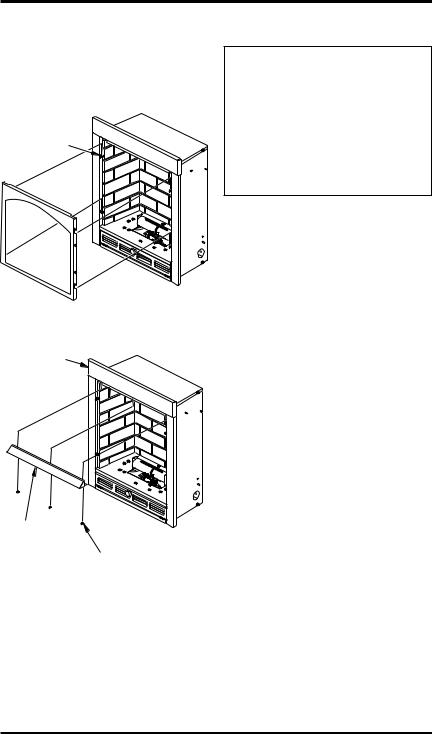
Assembly
Continued
5.Place hood under top edge of firebox opening. Use 3 screws from hardware kit to mount screen to firebox (see Figure 3).
Shoulder
Screw
 Screen
Screen
Figure 2 - Removing and Replacing
Screen
Top Trim
Panel
Hood
Screw
Figure 3 - Assembling Hood
Air for Combustion and Ventilation
 WARNING:Thisfireplaceshall not be installed in a confined spaceorunusuallytightconstructionunlessprovisionsareprovided for adequate combustion and ventilationair.Readthefollowing instructionstoinsureproperfresh airforthisandotherfuel-burning appliances in your home.
WARNING:Thisfireplaceshall not be installed in a confined spaceorunusuallytightconstructionunlessprovisionsareprovided for adequate combustion and ventilationair.Readthefollowing instructionstoinsureproperfresh airforthisandotherfuel-burning appliances in your home.
Today’s homes are built more energy efficient than ever. New materials, increased insulation and new construction methods help reduce heat loss in homes. Home owners weather strip and caulk around windows and doors to keep the cold air out and the warm air in. During heating months, home owners want their homes as airtight as possible.
While it is good to make your home energy effi- cient, your home needs to breathe. Fresh air must enter your home.All fuel-burning appliances need fresh air for proper combustion and ventilation.
Exhaust fans, fireplaces, clothes dryers and fuel burning appliances draw air from the house to operate. You must provide adequate fresh air for these appliances. This will insure proper venting of vented fuel-burning appliances.
PROVIDING ADEQUATE
VENTILATION
The following are excerpts from National Fuel Gas Code. ANSI Z223.1/NFPA 54, Section 5.3, Air for Combustion and Ventilation.
All spaces in homes fall into one of the three fol- lowing ventilation classifications:
1.Unusually Tight Construction
2.Unconfined Space
3.Confined Space
The information on pages 6 through 8 will help you classify your space and provide adequate ventilation.
The air that leaks around doors and windows may provide enough fresh air for combustion and ven- tilation. However, in buildings of unusually tight construction, you must provide additional fresh air.
www.desatech.com |
119315-01A |

AIR FOR COMBUSTION
AND VENTILATION
Continued
Unusually tight construction is defined as construction where:
a.walls and ceilings exposed to the outside atmosphere have a continuous water vapor retarder with a rating of one perm (6 x 10-11 kg per pa-sec-m2) or less with openings gasketed or sealed and
b.weather stripping has been added on openable windows and doors and
c.caulking or sealants are applied to areas such as joints around window and door frames, between sole plates and floors, between wall-ceiling joints, between wall panels, at penetrations for plumbing, electrical and gas lines and at other openings.
If your home meets all of these three criteria, you must provide additional fresh air. See Ventilation Air From Outdoors, page 8.
If your home does not meet all of the three criteria above, proceed to Determining Fresh-Air Flow For Fireplace Location.
Confined and Unconfined Space
The National Fuel Gas Code, ANSI Z223.1/NFPA 54 defines a confined space as a space whose volume is less than 50 ft3 per 1,000 Btu/hr (4.8 m3/kw) of the aggregate input rating of all appli- ances installed in that space and an unconfined space as a space whose volume is not less than 50 ft3 per 1,000 Btu/hr (4.8 m3/kw) of the ag- gregate input rating of all appliances installed in that space. Rooms communicating directly with the space in which the appliances are installed*, through openings not furnished with doors, are considered a part of the unconfined space.
* Adjoining rooms are communicating only if therearedoorlesspassagewaysorventilationgrills between them.
DETERMINING FRESH-AIR FLOW
FOR FIREPLACE LOCATION
Determining if You Have a Confined or
Unconfined Space
Use this work sheet to determine if you have a confined or unconfined space.
Space: Includes the room in which you will install fireplace plus any adjoining rooms with doorless pas- sageways or ventilation grills between the rooms.
1.Determine the volume of the space (length x width x height).
Length x Width x Height =__________cu. ft. (volume of space)
Example: Space size 16 ft. (length) x 14 ft. (width) x 8 ft. (ceiling height) = 1792 cu. ft. (volume of space)
If additional ventilation to adjoining room is supplied with grills or openings, add the volume of these rooms to the total volume of the space.
2.Multiply the space volume by 20 to determine the maximum Btu/Hr the space can support.
___________ (volumeofspace)x20=(Maximum Btu/Hr the space can support)
Example: 1792 cu. ft. (volume of space) x 20 = 35,840 (maximum Btu/Hr the space can support)
3.Add the Btu/Hr of all fuel burning appliances in the space.
Vent-free fireplace |
__________ Btu/Hr |
Gas water heater* |
__________ Btu/Hr |
Gas furnace |
__________ Btu/Hr |
Vented gas heater |
__________ Btu/Hr |
Gas fireplace logs |
__________ Btu/Hr |
Other gas appliances* |
+__________ Btu/Hr |
Total |
=__________ Btu/Hr |
* Do not include direct-vent gas appliances. Di- |
|||
rect-ventdrawscombustionairfromtheoutdoors |
|||
and vents to the outdoors. |
|
|
|
Example: |
|
30,000 |
|
Gas water heater |
|
Btu/Hr |
|
Vent-free fireplace |
+ |
10,000 |
Btu/Hr |
Total |
= |
40,000 |
Btu/Hr |
4.Compare the maximum Btu/Hr the space can support with the actual amount of Btu/Hr used.
__________ Btu/Hr (maximum the space can support)
__________ Btu/Hr (actual amount of Btu/Hr used)
Example: 35,840 Btu/Hr (maximum the space can support)
40,000 Btu/Hr (actual amount of Btu/Hr used)
119315-01A |
www.desatech.com |
|
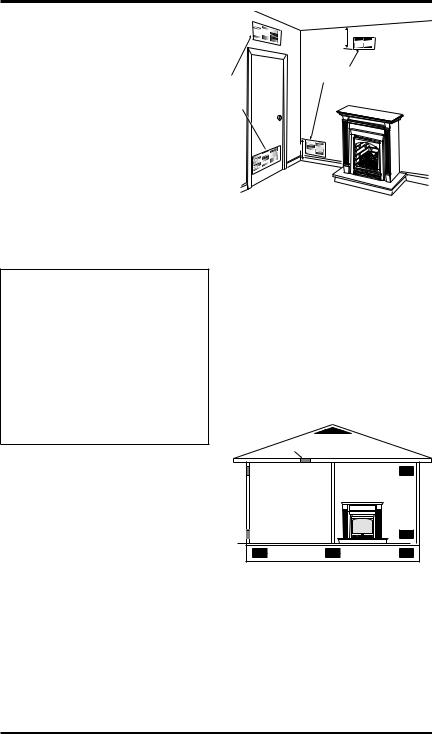
AIR FOR COMBUSTION
AND VENTILATION
Continued
The space in the example is a confined space because the actual Btu/Hr used is more than the maximum Btu/Hr the space can support. You must provide ad- ditional fresh air. Your options are as follows:
A.Reworkworksheet,addingthespaceofanadjoin- ingroom.Iftheextraspaceprovidesanunconfined space, remove door to adjoining room or add ventilation grills between rooms. See Ventilation Air From Inside Building.
B.Vent room directly to the outdoors. See Ventilation Air From Outdoors.
C.Install a lower Btu/Hr fireplace, if lower Btu/Hr size makes room unconfined.
IftheactualBtu/HrusedislessthanthemaximumBtu/Hr thespacecansupport,the space is an unconfined space. You will need no additional fresh air ventilation.
 WARNING:Iftheareainwhich the heater may be operated is smaller than that defined as an unconfined space or if the building is of unusually tight construction, provide adequate combustion and ventilation air byoneofthemethodsdescribed in the National Fuel Gas Code, ANSIZ223.1/NFPA54Section5.3 or applicable local codes.
WARNING:Iftheareainwhich the heater may be operated is smaller than that defined as an unconfined space or if the building is of unusually tight construction, provide adequate combustion and ventilation air byoneofthemethodsdescribed in the National Fuel Gas Code, ANSIZ223.1/NFPA54Section5.3 or applicable local codes.
VENTILATION AIR
Ventilation Air From Inside Building
This fresh air would come from an adjoining un- confined space. When ventilating to an adjoining unconfined space, you must provide two permanent openings: one within 12" of the ceiling and one within 12" of the floor on the wall connecting the two spaces (see options 1 and 2, Figure 4). You can also remove door into adjoining room (see option 3, Figure 4). Follow the National Fuel Gas Code, ANSI Z223.1/NFPA 54, Section 5.3, Air for Combustion and Ventilation for required size of ventilation grills or ducts.
|
|
12" |
|
|
|
Ventilation Grills |
|
Ventilation |
|
Into Adjoining Room, |
|
|
Option 2 |
||
Grills |
Or |
||
|
|||
into |
Remove |
|
|
Adjoining |
Door into |
|
|
Room, |
Adjoining |
|
|
Option 1 |
Room, |
|
|
|
Option 3 |
|
|
|
|
12" |
Figure 4 - Ventilation Air from Inside Building
Ventilation Air From Outdoors
Provideextrafreshairbyusingventilationgrillsor ducts.You must provide two permanent openings: one within 12" of the ceiling and one within 12" of the floor. Connect these items directly to the outdoors or spaces open to the outdoors. These spaces include attics and crawl spaces. Follow the
National Fuel Gas Code, ANSI Z223.1/NFPA 54, Section 5.3, Air for Combustion and Ventilation for required size of ventilation grills or ducts.
IMPORTANT: Do not provide openings for inlet or outlet air into attic if attic has a thermostatcontrolledpowervent.Heatedairenteringtheattic will activate the power vent.
|
Outlet |
Ventilated |
|
Attic |
|
|
Air |
|
|
|
|
Outlet |
|
|
Air |
|
To Attic |
|
|
|
|
|
To |
|
|
Crawl |
Inlet |
|
Space |
|
|
|
Air |
|
|
|
Inlet Air |
Ventilated |
|
Crawl Space |
|
|
|
Figure 5 - Ventilation Air from Outdoors
www.desatech.com |
119315-01A |

Installation
NOTICE: This heater is intended for use as supplemental heat. Use this heater along with your primary heating system. Do not install this heater as your primary heat source. If you have a centralheatingsystem,youmay run system’s circulating blower whileusingheater.Thiswillhelp circulatetheheatthroughoutthe house. In the event of a power outage, you can use this heater as your primary heat source.
 WARNING:Aqualifiedservice person must install fireplace.
WARNING:Aqualifiedservice person must install fireplace.
Follow all local codes.
 WARNING: Never install the fireplace
WARNING: Never install the fireplace
•in a bathroom
•in a recreational vehicle
•where curtains, furniture, clothing or other flammable objects are less than 36" from the front, top or sides of the fireplace
•as a fireplace insert
•in high traffic areas
•in windy or drafty areas
 CAUTION: This fireplace creates warm air currents. These currents move heat to wall surfacesnexttofireplace.Installing fireplacenexttovinylorclothwall coverings or operating fireplace where impurities (such as, but not limited to, tobacco smoke, aromatic candles, cleaning fluids, oil or kerosene lamps, etc.) intheairexist,maydiscolorwalls or cause odors.
CAUTION: This fireplace creates warm air currents. These currents move heat to wall surfacesnexttofireplace.Installing fireplacenexttovinylorclothwall coverings or operating fireplace where impurities (such as, but not limited to, tobacco smoke, aromatic candles, cleaning fluids, oil or kerosene lamps, etc.) intheairexist,maydiscolorwalls or cause odors.
IMPORTANT: Vent-free fireplaces add moisture totheair.Althoughthisisbeneficial,installingfire- place in rooms without enough ventilation air may causemildewtoformfromtoomuchmoisture.See
Air for Combustion and Ventilation, page 6.
Note: Yourfireplaceisdesignedtobeusedinzero clearance installations. Wall or framing material can be placed directly against any exterior surface on the rear, sides or top of your fireplace, except where standoff spacers are integrally attached. If standoff spacers are attached to your fireplace, these spacers can be placed directly against wall or framing materials.
Note: Wheninstallingfireplacedirectlyoncarpet- ing, tile or other combustible material, other than wood flooring, the fireplace shall be installed on a metal or wood panel extending the full width and depth of the fireplace.
Use the dimensions shown for rough openings to create the easiest installation (see Built-In Fireplace Installation, page 10).
CHECK GAS TYPE
Use the correct gas type (natural or propane/LP) for your unit. If your gas supply is not correct, do not install fireplace. Call dealer where you bought fireplace for proper type fireplace.
 WARNING: This appliance is equipped for natural or propane/LP gas. Field conversion is not permitted.
WARNING: This appliance is equipped for natural or propane/LP gas. Field conversion is not permitted.
INSTALLATION ITEMS
Before installing fireplace, make sure you have the items listed below.
•external regulator (supplied by installer, for propane/LP units only)
•piping (check local codes)
•sealant (resistant to propane/LP gas)
•equipment shutoff valve *
•test gauge connection*
•ground joint union
•sediment trap
•tee joint
•pipe wrench
*ACSAdesign-certified equipment shutoff valve with 1/8" NPT tap is an acceptable alternative to test gauge connection. Purchase the optional CSA design-certifiedequipmentshutoffvalvefromyour dealer. See Accessories, page 34.
119315-01A |
www.desatech.com |
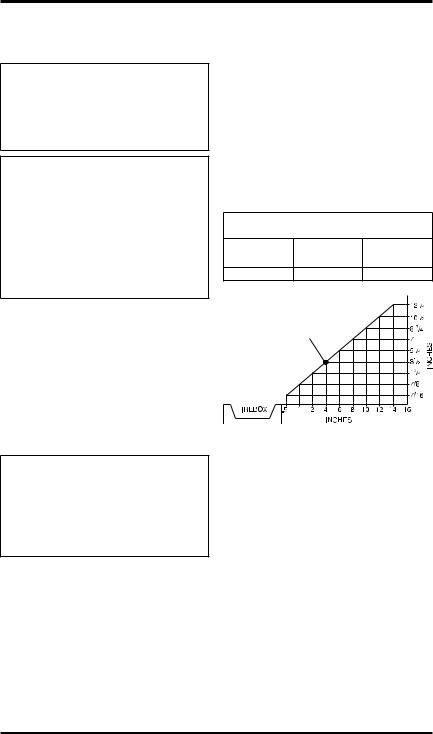
INSTALLATION
Continued
Fireplace Clearances
 WARNING: Maintain the minimum clearances shown in Figure 6. If you can, provide greater clearances from floor, ceiling and joining wall.
WARNING: Maintain the minimum clearances shown in Figure 6. If you can, provide greater clearances from floor, ceiling and joining wall.
NOTICE: If you install the fireplace in a bedroom, some building codes require that the fireplace/mantel system be secured to (or within) a wall. You can position fireplace in an optional cabinet or corner mantel.
You can also recess fireplace into the wall.
If your fireplace is to be used with an optional mantel, the installation instructions included with your mantel shows an CSA approved method of attaching the fireplace/mantel system to a wall. IMPORTANT: Only use optional cabinet or corner mantels specified in this manual. Purchase the optional mantel from your dealer (see Accessories, page 34).
If your fireplace is to be recessed into the wall, see Built-In Fireplace Installation to secure your fireplace into the wall.
 CAUTION: If you install the fireplace in a home garage
CAUTION: If you install the fireplace in a home garage
•fireplacepilotandburnermust be at least 18" above floor.
•locatefireplacewheremoving vehicle will not hit it.
For convenience and efficiency, install fireplace
•wherethereiseasyaccessforoperation,inspec- tion and service
•in coldest part of room
MinimumClearancesForSideCombustible
Material, Side Wall and Ceiling
A. Clearances from the side of the fireplace cabinet to any combustible material and wall should follow diagram in Figure 6.
Example: The face of a mantel, bookshelf, etc. is made of combustible material and protrudes 3 1/2" from the wall. This combus- tible material must be 4" from the side of the fireplace opening (see Figure 6).
B. Clearances from the top of the fireplace opening to the ceiling should not be less than 36".
C. For mantel clearances, see Figure 10 on page 13.
MINIMUM CLEARANCE TO
COMBUSTIBLE MATERIALS
Top |
Left and |
Bottom and |
|
Right Sides |
Rear |
||
|
36" |
6" |
0" |
|
Example |
|
|
|
* |
*Minimum 16" from Side Wall
Figure 6 - Minimum Clearance for Combustible to Wall
Built-In Fireplace Installation
Built-ininstallationofthisfireplaceinvolvesinstall- ingfireplaceintoaframed-inenclosure.Thismakes the front of fireplace flush with wall. Fireplace face will extend past sides and top of fireplace approxi- mately 1". This will cover the rough edges of the wall opening. If installing a built-in mantel above thefireplace,youmustfollowtheclearancesshown in Figure 9, page 12. To install the fireplace in this manner, use the following instructions.
10 |
www.desatech.com |
119315-01A |
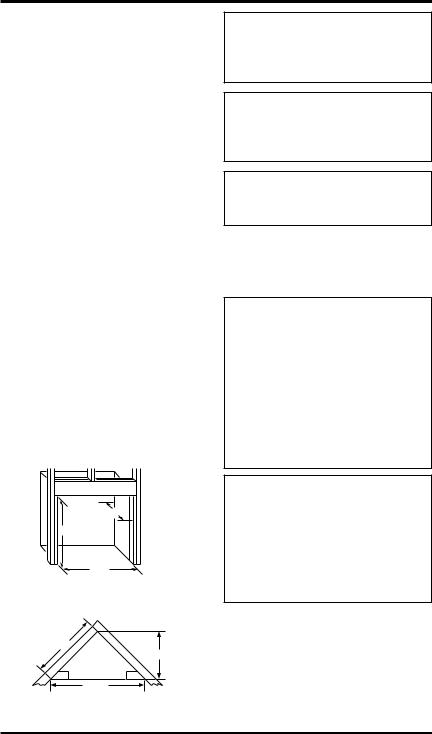
INSTALLATION
Continued
|
Actual |
Framing |
Height |
23 3/4" |
22 1/4" |
Front Width |
19 3/4" |
17 1/2" |
Depth |
8 7/8" |
8 7/8" |
Bottom |
0" |
0" |
1.Frameinroughopening.Usedimensionsshown inFigure7fortheroughopening.Ifinstallingin a corner, use dimensions shown in Figure 8 for the rough opening. The height is 22 1/4" which is the same as the wall opening above.
2.Install gas piping to fireplace location. This installation includes an approved flexible gas line(ifallowedbylocalcodes)aftertheequip- ment shutoff valve.The flexible gas line must be the last item installed on the gas piping.
3.If you have not assembled firebox, follow instructions on page 6.
4.Carefullysetfireplaceinfrontofroughopening with back of fireplace inside wall opening.
5.Attachflexiblegaslinetofireplacegasregula- tor. See Connecting Fireplace to Gas Supply, page 14.
6.Check all gas connections for leaks. See
Checking Gas Connections, page 15.
IMPORTANT: When finishing your firebox, combustible materials such as wall board, gypsum board, sheet rock, drywall, plywood, etc. may be butted up next to the sides and top edge of the fire- box. Combustible materials should never overlap the firebox front facing.
8 7/8"
221/4"
171/2"
Figure 7 - Rough Opening for Installing in Wall
 WARNING: Do not allow any combustibleornoncombustible materials to overlap the firebox front facing.
WARNING: Do not allow any combustibleornoncombustible materials to overlap the firebox front facing.
 WARNING: Do not allow noncombustible materials to cover any necessary openings like louvered slots.
WARNING: Do not allow noncombustible materials to cover any necessary openings like louvered slots.
 WARNING: Never modify or cover the louvered slots on the front of the firebox.
WARNING: Never modify or cover the louvered slots on the front of the firebox.
Mantel Clearances for Built-In
Installation
Ifplacingmantelabovebuilt-infireplace,youmust meetminimumclearancebetweenmantelshelfand top of fireplace opening.
NOTICE: Surface temperatures of adjacent walls and mantels become hot during operation. Walls and mantels above the firebox may become hot to the touch. If installed properly, these temperatures meet the requirement of the national product standard. Follow all minimum clearances shown in this manual.
NOTICE: If your installation does not meet the minimum clearances shown in Figure 9, page 12, you must do one of the following:
•raise the mantel to an acceptable height
•remove the mantel
297/8"
211/8"
 171/2"
171/2"  421/4"
421/4"
Figure 8 - Rough Opening for Installing in Corner
119315-01A |
www.desatech.com |
11 |
